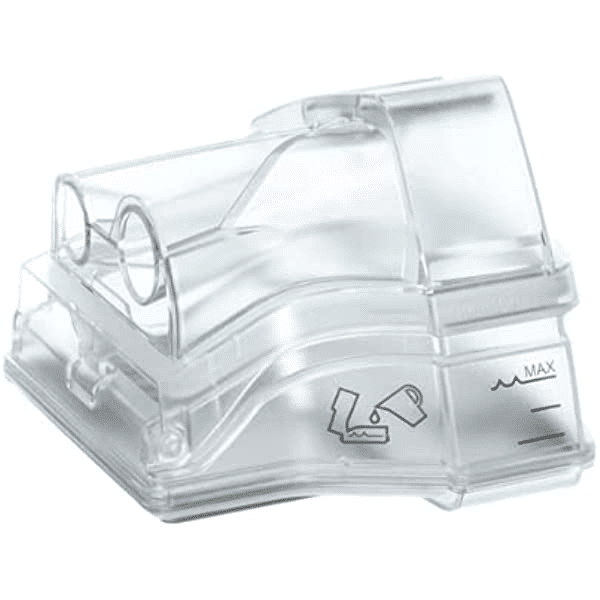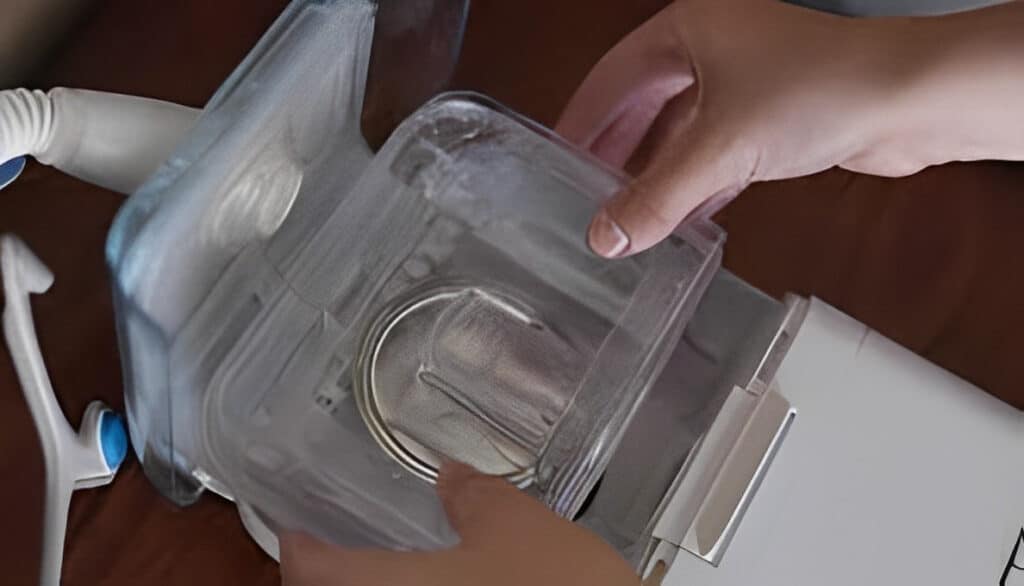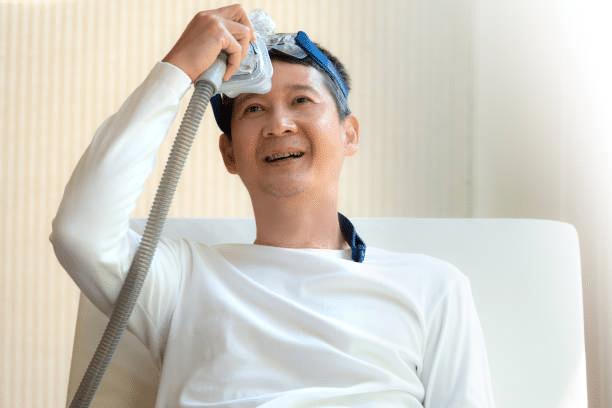Understanding how to stop mold and bacteria in your CPAP water chamber is crucial for maintaining both the effectiveness of the machine and your health. Mold and bacteria thrive in moist environments, and a CPAP humidifier chamber, if left unattended, can become an ideal habitat for these harmful microorganisms. This can lead to respiratory infections and diminish the overall benefits of your CPAP therapy.
In this guide, we will explore practical and effective strategies to prevent the growth of mold and bacteria in your CPAP water chamber, ensuring a safe and hygienic experience with your CPAP machine.
Role of The Humidifier Water Chamber In CPAP Therapy

The CPAP humidifier tank plays a crucial role in enhancing the comfort and effectiveness of the therapy for sleep apnea sufferers. By adding moisture to the room temperature air delivered by the CPAP device, The CPAP humidifiers ensure that the respiratory system remains hydrated and reduces the likelihood of a sore throat, runny nose, and nasal irritation caused by dry air. The water chamber is essential to the CPAP humidifier, holding the heated water and turning it into vapor during therapy.
Understanding Mold And Bacteria In CPAP Water Chambers
Mold and bacteria in CPAP water chambers can be attributed to several factors. The warm, moist environment created by the heated humidifier is ideal for the proliferation of mold spores and bacteria. In addition, using tap water instead of distilled water can lead to mineral buildup, providing a suitable surface for these microorganisms to grow. Furthermore, inadequate or infrequent cleaning of CPAP components, such as the water tank, mask, and hose, can contribute to mold and bacteria growth.
Health Risks Associated with Contaminated Water Chambers
Exposure to mold and bacteria from contaminated CPAP water chambers can result in various health hazards for CPAP users. During CPAP treatment, respiratory symptoms, such as a runny nose, sore throat, and cough, can be aggravated or triggered by inhaling mold spores and bacteria. Mold can also lead to allergic reactions, skin irritation, and sinus infections. In more severe cases, mold and bacteria can cause serious health concerns, particularly in individuals with compromised immune systems or pre-existing respiratory conditions.
Types of Mold and Bacteria Found in CPAP Water Chambers
If improperly maintained, various types of mold and bacteria can be found in CPAP water chambers. Some common mold species include;
- Aspergillus
- Cladosporium
- Penicillium
These molds can produce allergens and mycotoxins, which can cause allergic reactions and other health issues in CPAP users. In addition to mold, bacteria such as:
- Pseudomonas aeruginosa
- Staphylococcus aureus
- Legionella
These can contaminate the water chamber. These bacteria can cause respiratory infections and other complications if inhaled during CPAP treatment.
CPAP users need to take preventive measures and regularly clean their equipment to minimize the risk of mold and bacteria growth, ensuring the safety and effectiveness of their sleep apnea therapy.
Now, How To Stop Mold And Bacteria In Your CPAP Water Chamber?

Let’s delve into daily cleaning, weekly deep cleaning, and other essential steps to prevent mold and bacteria growth in your CPAP machine.
Daily Cleaning Of The Water Chamber:
To prevent mold growth and bacteria buildup in your CPAP equipment, cleaning the water chamber daily is crucial. After each use, empty any remaining water from the tank, and rinse it with warm water. Use a soft cloth or sponge to gently scrub the inside of the chamber, removing any mineral buildup or residue. Ensure to air dry the water chamber entirely before refilling it with distilled water for your subsequent treatment.
Weekly Deep Cleaning With A Mild Soap Or CPAP Cleaner Device
In addition to daily cleaning, a thorough weekly deep cleaning of the CPAP water chamber is recommended. Use warm water, mild soap, or specialized CPAP cleaners to disinfect the chamber. Ensure that all components, including the mask, hose, and nasal pillows, are cleaned to maintain a sanitary CPAP system. After cleaning, rinse all parts thoroughly to remove soap residue and allow them to air dry completely.
Using Distilled Water
Using distilled water in your CPAP humidifier tank is essential to minimize mineral buildup and prevent mold development. Unlike tap water, distilled water is free of minerals and impurities that can accumulate in the water chamber, creating a conducive environment for mold and bacteria.
Emptying And Drying The Water Chamber Daily
To reduce the mold and bacteria growth risk, always empty the water chamber after each use and allow it to air dry. This practice ensures that the humidifier tanks remain clean and dry, inhibiting the growth of harmful microorganisms.
Replacing The Water Chamber and Other CPAP Components
Over time, the water chamber and other CPAP components can wear down or become damaged, increasing the risk of mold and bacteria growth. Follow the recommendations of CPAP machine manufacturers to replace the CPAP water tank, filters, mask, and other parts as needed to maintain a hygienic and efficient CPAP system.
Using A Heated Hose To Minimize Condensation
A heated hose can help maintain a consistent temperature throughout the CPAP treatment, reducing condensation within the hose and mask. This minimizes the risk of mold and bacteria growth and ensures that the air you breathe during therapy remains clean and safe.
By incorporating these preventive measures into your daily and weekly routines, you can effectively reduce the risk of mold and bacteria growth in your CPAP water chamber and maintain a clean and healthy sleep apnea treatment experience.
Importance Of Proper Storage

Proper storage of your CPAP machine is crucial in preventing mold development and maintaining the overall cleanliness of the equipment. Always store your CPAP device in a clean and dry environment, away from dust and humidity, to minimize the risk of contamination. Ensure the water chamber is emptied and all components thoroughly air-dried before storing the machine.
Avoiding Exposure To Sunlight And Extreme Temperatures
Prolonged exposure to direct sunlight and extreme temperatures can damage the CPAP components, making them more susceptible to mold growth and bacteria. Store your CPAP machine and accessories in a cool, shaded area, away from direct sunlight or heat sources. This will help preserve the integrity of the equipment and ensure optimal performance during sleep apnea treatment.
Proper Storage Of CPAP Accessories (Masks, Hoses, Filters)
In addition to storing the CPAP machine, it is essential to properly store all CPAP accessories, including masks, hoses, and filters. Keep these components in a clean, dry container or storage bag when not in use. Regularly clean and inspect the accessories for signs of wear or damage, replacing them as needed to maintain a hygienic and efficient CPAP system.
Signs Of Mold And Bacteria In Your CPAP Water Chamber
One of the most obvious signs of mold or bacteria growth in your CPAP water chamber is visible contamination. This can include discolored spots, slimy residue, or a cloudy appearance in the water. Be vigilant and inspect your water chamber regularly for any signs of contamination.
Unpleasant Odors or Tastes
Unusual or unpleasant odors or tastes from your CPAP machine may indicate the presence of mold or bacteria. If you notice a musty, sour, or foul smell or taste, inspecting your equipment and cleaning or replacing any contaminated components immediately is essential.
Respiratory Symptoms or Skin Irritation
If you experience respiratory symptoms such as a runny nose, sore throat, or increased congestion, or if you develop skin irritation around your CPAP mask, these may be signs of mold or bacteria exposure. In this case, you must consult with your sleep specialist or CPAP provider for guidance and a thorough inspection of your equipment.
Also Read: CPAP Mask Nose Irritation: Tips For a Comfortable Sleep
Decreased CPAP Machine Performance
If you notice a decrease in the performance of your CPAP machine, such as reduced airflow or increased noise, it may be a sign of contamination in your water chamber or other components. Mold and bacteria can obstruct the proper function of your CPAP device, making it essential to address the issue promptly to ensure optimal treatment results.
By staying vigilant for these signs of mold and bacteria growth in your CPAP water chamber, you can immediately address the issue, protecting both your health and the effectiveness of your sleep apnea treatment. Regularly inspecting and maintaining your CPAP equipment, including preventing bacteria in CPAP machines, is crucial for avoiding contamination and ensuring a safe, comfortable sleep experience.
What to Do If You Suspect Mold or Bacteria Contamination
Immediate Steps To Address The Issue:
- Discontinue Use Of The Contaminated Equipment:
If you suspect mold or bacteria contamination in your CPAP machine, immediately stop using the affected equipment to prevent further exposure to harmful microorganisms. Using contaminated CPAP components can pose serious health concerns and exacerbate respiratory issues.
- Thoroughly Clean Or Replace Affected Components:
Once you have identified the contaminated parts, it is essential to thoroughly clean or replace them as needed. For removable components such as the water chamber, mask, and hose, perform a deep cleaning using warm water, mild soap, or a specialized CPAP cleaner. If the contamination is severe or the components are damaged, consider replacing them entirely. Remember to replace filters, as mold spores and bacteria can accumulate on these components.
Get Sleep Help: Consult A Specialist Or CPAP Provider

If you need clarification about the extent of mold or bacteria contamination in your CPAP equipment or need guidance on proper cleaning and maintenance procedures, consult a sleep specialist or your CPAP provider. They can offer expert advice on how to address the issue and ensure the safety and effectiveness of your sleep apnea treatment. Additionally, they may recommend alternative treatment options or provide information on the latest CPAP cleaning devices, such as those that utilize UV light or hydrogen peroxide to disinfect your equipment.
Additional Tips For CPAP Users
- Importance Of Regular Checkups With A Sleep Specialist
Regular checkups with a sleep specialist are crucial for CPAP users to ensure optimal treatment and address any potential issues that may arise, such as mold growth or equipment malfunction. These checkups allow the specialist to monitor your progress, adjust your CPAP settings as needed, and provide guidance on maintaining your equipment for optimal performance.
- Keeping A Regular Sleep Schedule
Maintaining a consistent sleep schedule is essential for CPAP users as it helps promote healthy sleep patterns and ensures the effectiveness of sleep apnea treatment. Going to bed and waking up at the same time each day can help regulate your body’s internal clock, improving the quality of your sleep and overall health.
- Maintaining A Clean And Healthy Sleep Environment
In addition to proper CPAP equipment care, it is vital to maintain a clean and healthy sleep environment. This includes regularly washing your bedding, keeping your bedroom free of dust and allergens, and maintaining a comfortable room temperature. A clean sleep environment can help prevent respiratory issues, minimize mold exposure, and contribute to a better night’s sleep.
Enhancing CPAP Safety: Prevent Mold and Bacteria Growth

Preventing mold and bacteria growth in CPAP water chambers is crucial for sleep apnea patients who rely on these devices for effective treatment. Understanding how to stop mold and bacteria in your CPAP water chamber is not just about enhancing the device’s longevity but also about safeguarding your health. Mold and bacteria can pose serious health concerns, exacerbate existing respiratory issues, and compromise the overall effectiveness of CPAP therapy.
A commitment to proper care and maintenance of CPAP equipment, including regular cleaning of the water chamber, using distilled water, and replacing components as needed, can significantly reduce the risk of mold and bacteria growth. By following the guidelines outlined in this article, CPAP users can ensure the safety and efficiency of their devices, ultimately contributing to improved therapy results.
Maintaining a clean CPAP system helps prevent mold and bacteria growth and contributes to a better overall sleep experience for sleep apnea patients. A clean and well-maintained CPAP machine can lead to fewer complications, such as nasal congestion or sore throat, and a more robust immune system. Moreover, it helps patients avoid potential health hazards associated with mold exposure, ultimately supporting a healthier lifestyle and more effective sleep apnea treatment.
For all your CPAP maintenance needs, including top-quality accessories designed to keep your CPAP water chamber free from mold and bacteria, visit our Amazon shop. Equip yourself with the best tools to protect your health while enjoying the benefits of uninterrupted sleep.




